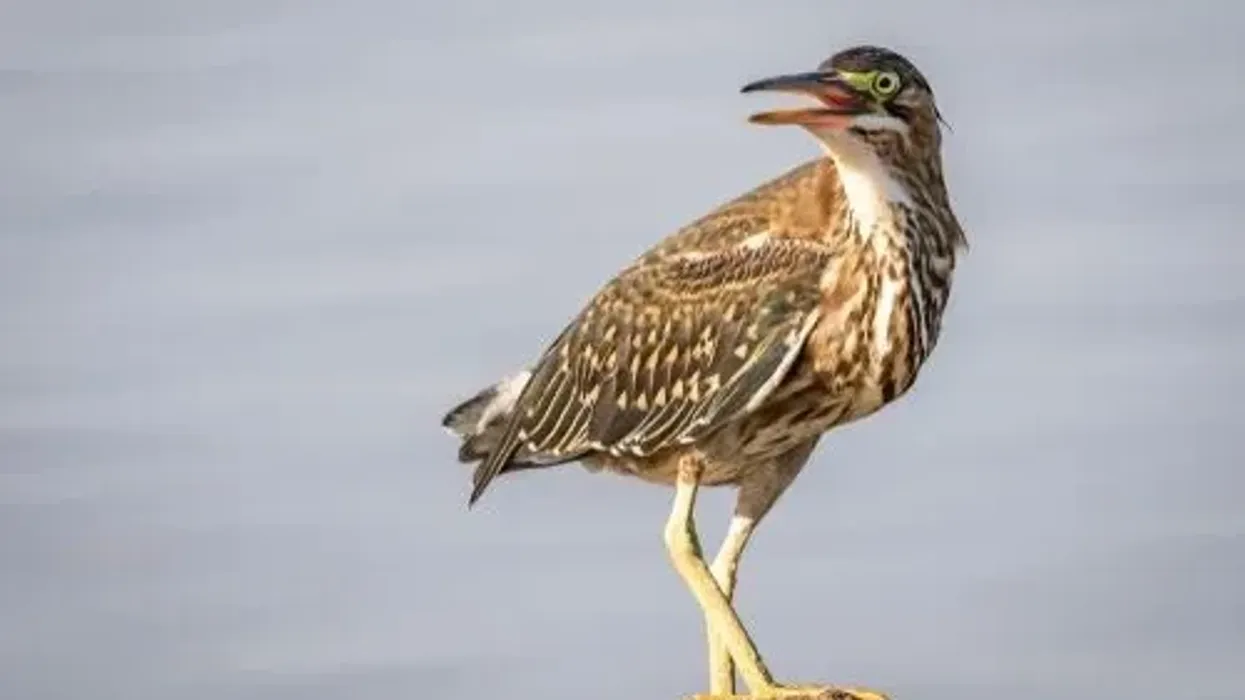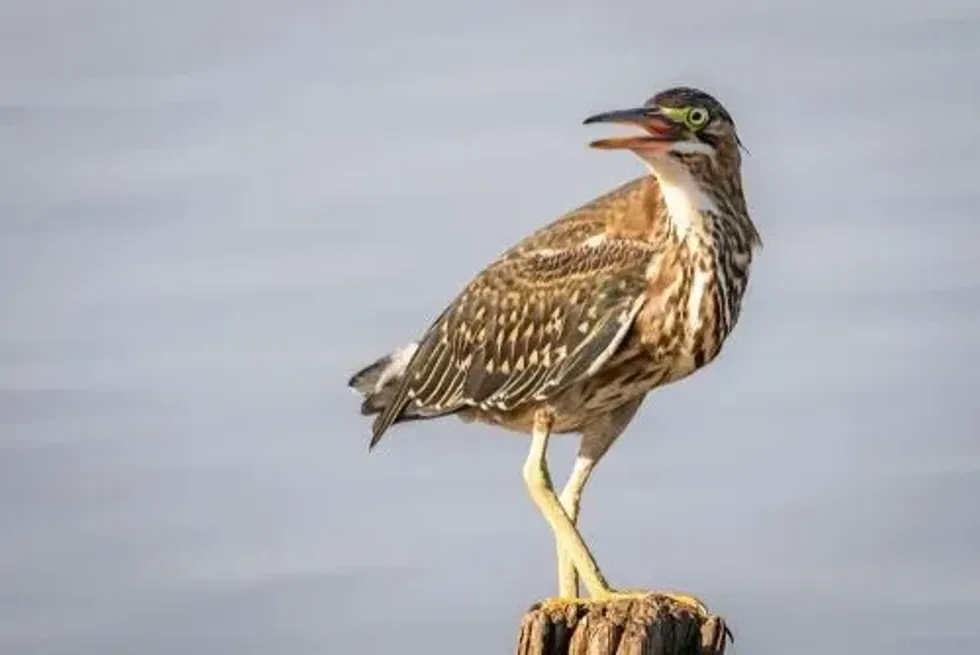The Green heron (Butorides virescens) is a North American bird that majorly preys on fish like carp, catfish, eels, shad, goldfish, silverside, and many more. For this food habit, they prefer to live near wetlands, water bodies, and rivers surrounded or lined by trees and bushes.
Their breeding occurs in the summer, mainly during May. The loud call of the male herons is one of their characteristic features.
Males take their share of responsibility in building the nest and taking good care of the offspring. Young birds depend on their parents for food until they are ready to prey on fish. The little green heron is not prominently green but has green streaks on several body parts.
Other than the breeding season, these birds are mostly solitary and secretive. They like to spend a private life.
The green heron is one of the few intelligent bird species that knows to use tools. It is evident in their way of catching fish from shallow, or sometimes, deep water bodies.
If you love birds and want to about some more, you can always check out our other articles like pileated woodpecker and house finch.
Green Heron Interesting Facts
What type of animal is a green heron?
Green herons are a species of herons, found in North America and Central America.
What class of animal does a green heron belong to?
The green heron is a North American bird.
How many green heron are there in the world?
There are 1,337,248 green herons in the world, according to the Cornell Lab of Ornithology.
Where does a green heron live?
Green herons live in wetlands and other shallow water bodies.
What is a green heron's habitat?
Green herons nest around swamps, marshes, ponds, and lakes, and near streamline with thick forest on both sides. They may even live in dry woods and make their nest there if it is near water. They use both coastal and inland wetlands as their habitat.
Who do green herons live with?
Green herons are solitary predators, but they are fairly sociable in the breeding season.
How long does a green heron live?
The oldest green heron was found in Mexico, and was seven years and 11 months old.
How do they reproduce?
Green herons are seasonally monogamous, i.e. they mate with one partner each season.
They snap their bill, stretch their necks, flap their wings exaggeratedly, and call loudly during courtship. Their nests may be solitary or in a colony. Male birds of this species participate actively in looking after the offspring along with the females.
The male starts building a nest even before finding a mating partner. He chooses a suitable place in his territory for nesting.
Usually, a large fork of a tree or bush, concealed by overhanging branches, is preferred by them for nesting. Oak, pine, willow, cedar, honey locust, and mangroves serve as good nest sites.
After mating, the male surrenders most of the building work to the female. Males collect long, thin sticks; and females use them to make a nest with a diameter of 8-12 in (20.3-30.5 cm) and a depth of 2 in (5 cm).
They may sometimes renovate old nests of black-crowned night-herons or snowy egrets, or use stickers from them to build a new one.
Both the male and female brood and protect their nest from possible predators like crows, raccoons, grackles, and snakes. Both the parents feed the chicks after hatching.
The incubation period is 19-21 days on average. Eggs are pale to bluish-green, 1.3-1.7 in (3.3-4.3 cm) long, and 1.1-1.4 in (2.8-3.6 cm) wide.
The chicks leave the nest when they are 30-35 days old. The young birds may stay for a month or more with their parents after leaving the nest as they learn to capture prey or other survival necessities.
What is their conservation status?
Their conservation status as per the IUCN Red List has been listed as Least Concern. If green heron bird facts are to be believed, they have a steady and healthy population that is thriving in spite of continued habitat destruction.
This onslaught on habitat has, however, taken a toll finding prey, locating potential prey, or even general availability of prey.
This in turn has taken a toll on the breeding activities of the bird. Breeding initiatives should be taken to ensure that the young birds are properly nurtured and the population is stable.
Green Heron Fun Facts
What do green herons look like?
The green heron (Butorides virescens) is a medium-sized, 16.1-18.1 in (41-46 cm) long, that is found in North and Central America. The adult green herons have a glossy greenish-black cap, dark green back and wings, and chestnut neck and chest with a vertical white line along the ventral side.
The green heron's neck is thick and tightly drawn into the body. Their bill is dark and daggerlike. Females are shorter than male ones.
The young birds are duller and lighter in color, with streaks of brown and white at the sides of the head and neck, and lower parts of the body. The green herons have short yellow legs.

How cute are they?
Birds, in general, possess a certain degree of cuteness. Members of this species, namely green herons, are no different in this aspect.
How do they communicate?
In usual times, green herons do not like the proximity of other birds, not even members of their own species - especially during the time of eating. In the breeding season, they stretch their neck, call loudly, and fly vigorously during courtship.
Despite preferring to be solitary in other times, during the breeding season they are very family-oriented.
Male birds actively participate in building the nest and taking care of the eggs and later the young birds. Parents feed the juvenile together until they get accustomed to the environment and the ways to prey.
How big is a green heron?
These North American birds are approximately 16.1-18.1 in (41-46 cm) in length. They are usually as big as an owl.
How fast can a green heron fly?
Green herons are not among the remarkably fast fliers. They flap their wings at an average rate of 2.8-3.8 beats per second. Their wing movements are slow and steady.
How much does a green heron weigh?
Green herons weigh around 8.5 oz (241 g).
What are their male and female names of the species?
The male and the female members of the species do not have unique names specific to their gender.
What would you call a baby green heron?
Like most other birds, the baby green herons are called hatchlings just after the hatching of the eggs; and a few days older young birds are called chicks.
What do they eat?
Green herons mostly prey on small fish from shallow water. They can be found around fish hatcheries apart from their natural habitat for this reason. Apart from that, small invertebrates, amphibians, reptiles, and rodents are also their prey.
Are they dangerous?
These North American birds are shy and secretive in nature. Green herons do not go around minding others' business.
However, they may attack out of irritation if provoked, like any other creature. And their bill is not something that one would like to face. But in general, humans are much more threatening to the birds than they are to humans.
Would they make a good pet?
As privacy is their priority and they do not like to interact much, it is not hard to understand that green herons would not make a good pet. And truth be told, wild creatures such as these birds are best left in the wild for their own good.
Did you know...
Green herons are one of the most intelligent bird species. An example of such intelligence was recorded by a Florida resident.
The resident would often give crumbs to the green heron. However, the green heron is more prone to getting fish, which is much more flavorsome than crumbs. So, it was observed that the green heron would take the crumbs in their mouth and then, position the crumbs strategically on the water surface.
This way, when the fish came up to the surface to explore or nibble on the crumbs, the green heron would plunge in on them. If they saw the crumbs floating away, they would often reposition them.
The green heron is one of the few tool-using birds according to the Cornell Lab of Ornithology. They have the concept of using bait to catch fish. They drop insects or other items in the water to lure the fish. When the fish comes near the water surface to eat the bait, the bird eats the fish.
They are basically nocturnal as they prefer to move in secret. They forage in the night and come to the nest in the morning. However, they can take food at any time during the day and night.
Till the year 1939, green herons were not spotted anywhere near Washington. It was only spotted erratically spread out across west Washington post-1939. The first nest was discovered back in 1960.
The small green heron skeleton can be a little deceiving. The neck especially is a thing of deception. If you look at a green heron, they may appear to you as really stout.
But if you observe them carefully, you may find out that they can often extend their neck as high as they want. The small neck extends when they are startled or when they are looking at something high. So, the small heron is not so small after all.
When it comes to the role of the green heron in our ecosystem, then the relationship is clear. They are a part of the aquatic ecosystem, preying on fish.
As a positive for humans, birdwatchers or ornithologists love green herons and observe them often. There is no negative effect that a green heron can have on the ecosystem. They have minimal effect on fishing.
Naming The Green Heron
The green herons are so named because of their glossy greenish-black cap, back, and wings. Their scientific name, Butorides virescens, has been derived from the middle-age English word 'butor' which means 'bittern', Ancient Greek '-oides' which means 'resembling', and Latin 'virescens' meaning 'greenish'.
The Green Heron's Call
The green heron call has a variety of sounds and respective meanings. Their usual call is a loud and sudden 'kyow', or a series of deep 'kuk' sounds.
However, herons are mostly known for the deep booming calls of the males in the breeding season. The courtship calls sound like 'raah raah' or 'roo roo'. When fighting, they make a 'whoom whoom' noise.
Here at Kidadl, we have carefully created lots of interesting family-friendly animal facts for everyone to discover! Learn more about some other birds including budgerigar, or great green macaw.
You can even occupy yourself at home by drawing one on our heron coloring pages.









